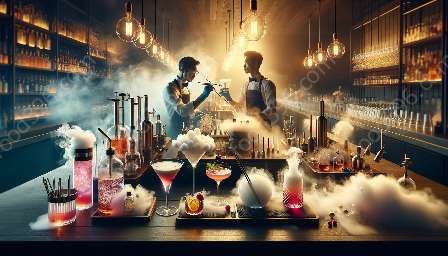Molecular mixology is a fascinating blend of science and art, where creative and inventive techniques are used to enhance the texture, flavor, and presentation of cocktails. In this article, we'll delve into the world of texture-enhancing techniques, with a focus on foam and spherification, and explore how these methods contribute to the captivating experience of molecular mixology.
Understanding Molecular Mixology
Molecular mixology, also known as mixology, is the art and science of creating innovative and unique cocktails by using avant-garde techniques and ingredients. This modern approach to mixology embraces scientific principles, such as physics and chemistry, to transform the texture, appearance, and taste of traditional cocktails, resulting in extraordinary and awe-inspiring creations.
Texture-Enhancing Techniques
Texture is a crucial element in the world of mixology, as it significantly influences the overall drinking experience. Texture-enhancing techniques play a pivotal role in molecular mixology, allowing bartenders and mixologists to elevate the sensory dimensions of cocktails.
Foam Techniques
Foam is a popular texture-enhancing technique that adds a compelling visual and tactile element to cocktails. By incorporating foams into cocktails, mixologists can create a velvety and luxurious mouthfeel, enhancing the overall drinking experience. Foam can be achieved through various methods, such as the use of foaming agents, like soy lecithin, and the application of pressure through nitrous oxide chargers.
One of the most iconic foam cocktails is the classic Gin Fizz, which features a luscious layer of egg white foam that beautifully complements the flavors of the drink.
Spherification Techniques
Spherification is a transformative technique that introduces spherical encapsulations of flavorful liquids into cocktails. This method, popularized by renowned chef Ferran Adrià, involves creating delicate and captivating spheres using sodium alginate and calcium chloride solutions. The result is a visually striking and texturally intriguing addition to cocktails.
Spherification can be employed to infuse cocktails with bursts of flavor, as the spheres release their contents in the mouth, providing a delightful and surprising experience for the imbiber.
Enhancing the Molecular Mixology Experience
Both foam and spherification techniques play a significant role in enhancing the molecular mixology experience. These texture-enhancing methods not only elevate the visual and tactile aspects of cocktails but also contribute to the overall sensorial journey of cocktail consumption.
When combined with other molecular mixology techniques, such as emulsification, gelification, and liquid nitrogen infusion, foam and spherification techniques open up a world of possibilities for creating innovative and captivating cocktail presentations.
Conclusion
Texture-enhancing techniques, such as foam and spherification, offer an exciting avenue for mixologists and bartenders to push the boundaries of traditional cocktail-making. These methods, deeply rooted in molecular mixology, inspire creativity and invite cocktail enthusiasts to embark on a sensorial adventure, where textures, flavors, and presentations harmoniously converge to deliver an unforgettable drinking experience.

